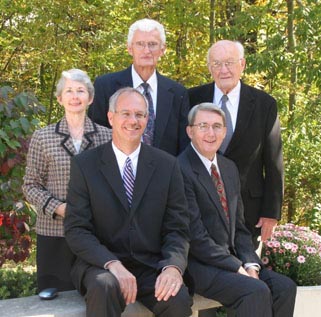
Living past presidents, in 2006
Clockwise from the right: Dr. Lee Snyder, Dr. Elmer Neufeld, Dr. Bob Kreider, Dr. Ben Sprunger, Dr. Jim Harder.
Past Bluffton presidents
Since 1899, the institution now known as Bluffton University has been led by only
ten presidents.
Dr. Noah C. Hirschy, 1900-08
Dr. Samuel K. Mosiman, 1910-35
The Rev. Dr. A.S. Rosenberger, 1935-38
Dr. Lloyd L Ramseyer, 1938-65
Dr. Robert S. Kreider, 1965-72
Dr. Benjamin Sprunger, 1972-77
Dr. Elmer Neufeld, 1978-96
Dr. Lee F. Snyder, 1996-2006
Dr. James M. Harder, 2006-2018
Dr. Jane M Wood, 2018-2025
Dr. Noah C. Hirschy
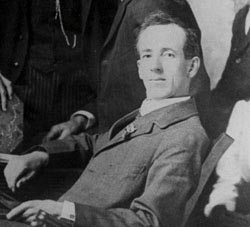 Noah Calvin Hirschy was born on a farm near Berne, Ind., to an Amish Mennonite family,
in a community where higher education was not encouraged. However Dr. Hirschy was
a scholar throughout his lifetime.
Noah Calvin Hirschy was born on a farm near Berne, Ind., to an Amish Mennonite family,
in a community where higher education was not encouraged. However Dr. Hirschy was
a scholar throughout his lifetime.
After graduating from the country school near his home, Hirschy taught four years in a small country school before going back to his studies where he earned a B.A. and B.D from Oberlin College. He was then called to be assistant pastor at Wadsworth First Mennonite Church. In 1894 he assumed full ministry .
When the Hirschys arrived in Bluffton, the family consisted of Noah, age 34, his wife Augusta Hunsberger Hirschy, and a 3 year old son, Hermon. A daughter, Lois Elizabeth, was born to them in 1904.
Although Noah Hirschy may have left the farm, his love of nature never left him. Students remember that, when he was at Bluffton, he always had some piece of nature in his lapel - a flower or a leaf or even a blade of grass.
Hirschy's love of nature was captured in marble when Bluffton College art professor John Klassen sculpted a likeness of Bluffton's first president. The bust of Hirschy stands in the lobby of Musselman Library. Careful notice will show that Klassen placed a violet in Hirschy's lapel. A fitting tribute to a man who, although a scholar through and through, recognized the beauty of God's nature each and every day.
Dr. Samuel K. Mosiman
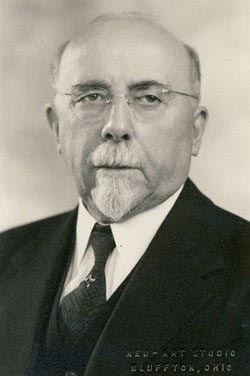 Samuel K. Mosiman, first came to Bluffton to teach. He joined the small faculty in
1908 as professor of Old Testament Languages and Philosophy. Mosiman's talent as an
administrator was recognized early on and, the following year, the board appointed
him as acting president. In 1910, that position was made permanent and he served as
Bluffton's second president for 25 years.
Samuel K. Mosiman, first came to Bluffton to teach. He joined the small faculty in
1908 as professor of Old Testament Languages and Philosophy. Mosiman's talent as an
administrator was recognized early on and, the following year, the board appointed
him as acting president. In 1910, that position was made permanent and he served as
Bluffton's second president for 25 years.
Mosiman earned a B.D. degree from McComick Theological Seminary in Chicago and a Ph.D. degree from Halle-Wittenburg University in Germany.
Samuel K. and Emilie Mosiman left a legacy that is not easily forgotten. Childless, the Mosimans gave the best of their lives to the people of this college community. Many students were familiar with the inside of the Mosiman house, especially students whose homes were far from Bluffton, as the Mosimans enjoyed the company of young people.
DID YOU KNOW...
The large, irregularly-shaped stone that lies on the front lawn of College Hall was
to be Dr. Samuel K. Mosiman's tombstone? It was requested at Mosiman's death that
a stone from his native community of Trenton should be placed at the head of his grave,
instead of the usual commercial stone. However, those in charge of the cemetery at
that time would not permit the stone to be placed at the gravesite.
A regular headstone with inscription was placed at Mosiman's grave in Bluffton's Maple Grove Cemetery. The rejected native stone was then moved to College Hall lawn. Later, Professor John Klassen created a bronze medallion with Mosiman's profile in relief. This medallion was then placed at an appropriate spot on the stone.
The Rev. Dr. Arthur S. Rosenberger
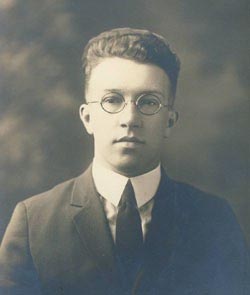 Arthur S. Rosenberger was born in Quakertown, Pa., in 1898, the oldest of four boys
in a Mennonite family. Nearly every summer and school vacation during Arthur's boyhood
were spent at his uncle's farm .
Arthur S. Rosenberger was born in Quakertown, Pa., in 1898, the oldest of four boys
in a Mennonite family. Nearly every summer and school vacation during Arthur's boyhood
were spent at his uncle's farm .
The love of agriculture drew Rosenberger to enroll at Penn State University, where he intended to study agriculture. However, the call of God moved him in another direction and his last two years of college were spent at Bluffton. Rosenberger was very active in campus life at Bluffton. Although he was a junior and new to the college in the fall of 1919, he was voted class president and May Day chairman during that year.
After receiving his degree in 1921, Rosenberger stayed on at Bluffton to continue his studies at Witmarsum Seminary, located in a building where Bren-Dell Hall now stands. He graduated from the seminary in 1923 and was ordained in Germantown Mennonite Church in Philadelphia.
The former Ella Habegger of Berne, Indiana, met her husband Arthur Rosenberger when they were both students at Bluffton. They wed and had three children, David, Elnore and Richard, who all graduated from Bluffton.
Arthur S. Rosenberger came to the presidency at a time when the college, and the nation, were trying to bring themselves out of the depths of the Great Depression. Dire financial problems at the college, coupled with faculty dissension and strained relations with the college's constituent churches, made for great tension on and off campus.
President Rosenberger's quiet, non-controversial manner in dealing with people gradually had a healing effect and confidence in the college was restored. But Rosenberger paid a high price for his work, as his health was shattered. He then sent in his resignation and returned to his much preferred field of work - the pastorate.
Dr. Lloyd L. Ramseyer
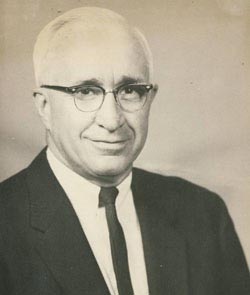 Lloyd L. Ramseyer did not set his sights towards becoming a college president. In
fact, when he accepted the position, he expected to stay no more than two or three
years. In actuality, he stayed for 27.
Lloyd L. Ramseyer did not set his sights towards becoming a college president. In
fact, when he accepted the position, he expected to stay no more than two or three
years. In actuality, he stayed for 27.
Born and raised on an Illinois farm to a devout Mennonite family, Ramseyer expected to live on the farm for the rest of his life. When Lloyd decided to go on to college, his father was less than enthusiastic. He recalls his father saying, "if you insist on going to college, you should go to our own school at Bluffton."
Ramseyer did go to Bluffton where he was active in debate, choirs and publications. He earned the nickname "Tank" on the football field. He also met his future wife, Ferne Yoder.
When the Ramseyer family moved back to Bluffton after living elsewhere, they came with three small children, Robert, Mary Jean and Billy, who spent their childhood completely surrounded by the college, as the family lived in the "Amstutz House," a small bungalow at the center of campus. Thus the children were well acquainted with campus long before they attended, and graduated from, the college.
One of the legacies Lloyd L. Ramseyer left to the college community was the excellence of his weekly chapel talks. Well received and appreciated by faculty and students alike, they were insightful as well as practical. Some of those chapel talks were collected into a book, The More Excellent Way, published by Faith and Life Press in 1965.
Dr. Robert S. Kreider
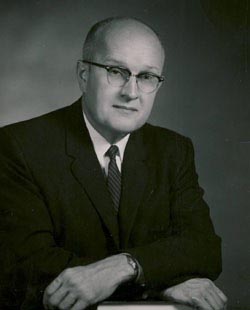 Robert Kreider became Bluffton's fifth president after having served the college as
professor of history and academic dean for the previous 13 years.
Robert Kreider became Bluffton's fifth president after having served the college as
professor of history and academic dean for the previous 13 years.
President Kreider graduated from Bluffton High School in 1935 but received his undergraduate degree from Bethel College in North Newton, Kan.
During WWII, he held a number of administrative positions in Civilian Public Service. He also was active in relief work in Germany following the war.
Through Mennonite Central Committee, Kreider assisted in the development of the Teachers Abroad Program. He was also involved in inter-Mennonite world relief and service agencies.
When Robert and Lois Kreider moved to Bluffton in 1952, to take a position in the history department, their first child, Esther, was only six months old. By the time the president handed in his resignation 20 years later, Esther was in college and her four siblings, Joan, Karen, David and Ruth, would follow close behind.
Near the end of the Kreider family's stay in Bluffton, Lois envisioned and founded the Et Cetera Shop, the first of what became hundreds of self-help stores selling crafts made in developing countries.
The 1990 exhibit, The Mirror of Martyrs, and its accompanying exhibition catalog, presented in collaboration with John S. Oyer, were the products of Kreider's interest in Mennonite history. The popular exhibit is still touring Mennonite communities throughout the United States and Canada.
Dr. Benjamin Sprunger
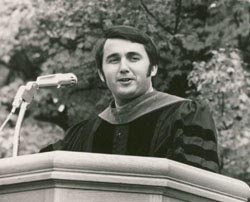 When Dr. Ben Sprunger was named Bluffton's president in 1972, he was, at age 35, one
of the youngest presidents in the history of the university.
When Dr. Ben Sprunger was named Bluffton's president in 1972, he was, at age 35, one
of the youngest presidents in the history of the university.
Just prior to becoming president, Sprunger was a senior planner for the National Institute of Education in Washington D.C.
During his term as president, Sprunger was one of 21 American educators who were privileged to travel to China for a month in the summer of 1975.
The Sprunger family resided in the red brick presidential residence on Grove Street, formerly the home of Dr. and Mrs. Moisman and, for a time, of Dr. and Mrs. Ramseyer. The Sprungers did considerable remodeling of the house during the time they lived there.
A former elementary school teacher, Sue Sprunger became very active in the community. She served on the nursery school board and became the first president of Bluffton Child Development Center. She was also on the original staff of the popular "Reaching Women" Christian retreat.
Ben Sprunger did not leave the college environment when he left Bluffton in 1977. He moved to Columbus where he became president of the Ohio Foundation of Independent Colleges, an organization to which Bluffton belongs.
From 1984 to 1991, Sprunger was CEO and director of Quest International, a drug and alcohol prevention organization. Sprunger then started his own company, "Life Skills International," which he headed until 1994.
Since 1994, Ben Sprunger has been president of Mennonite Economic Development Association (MEDA), an organization devoted to providing monetary and entrepreneurial assistance to small business owners throughout the world. He and his wife Sue continue to make their home in Columbus.
Dr. Elmer Neufeld
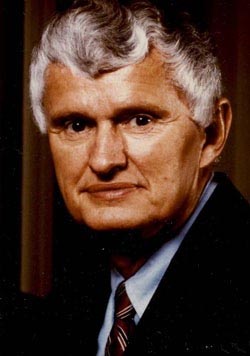 Dr. Elmer Neufeld came to the university as a professor, was later appointed academic dean and, following,
named president.
Dr. Elmer Neufeld came to the university as a professor, was later appointed academic dean and, following,
named president.
After college, Neufeld worked in Washington D.C. as associate secretary of the National Service Board for Religious Objectors. Later he became executive secretary of the Mennonite Central Committee (MCC) Peace Section.
From 1962 to 1965 Neufeld served MCC as program director in Zaire and as a peace missioner in sub-Sahara Africa. After his return from Africa in 1965, Neufeld came to Bluffton to teach philosophy. In 1974 he became academic dean and, on the first day of January 1978, he began his first term as Bluffton's seventh president.
President Neufeld served as president of the General Conference Mennonite Church for six years, was a board member and chairman of Mennonite Central Committee, and a member of various conference commissions.
The Neufelds had five children, all Bluffton graduates, Carolyn, Cynthia, Tim, Iris
and Francene.
One of the first projects Elmer tackled upon his retirement was to disassemble a 30-foot tall windmill which was on his home farm in Kansas, move it to Ohio and reassemble it on his small farm acreage at Bluffton. This displays his love for the country and how he never lost this love amidst his many presidential positions and busy life.
Dr. Lee F. Snyder
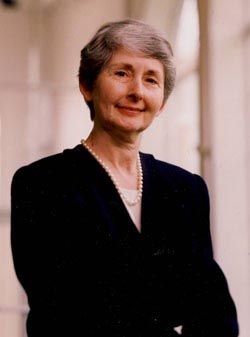 Dr. Lee Snyder joined the Bluffton community in the summer of 1996. She came from
Eastern Mennonite University where she had served as vice president and academic dean.
Dr. Lee Snyder joined the Bluffton community in the summer of 1996. She came from
Eastern Mennonite University where she had served as vice president and academic dean.
Born to a Mennonite farm family living in Oregon's Willamette Valley, Snyder received her undergraduate degree in English from the University of Oregon in 1972. In 1974, Snyder took a position as assistant to the academic dean at Eastern Mennonite University. She was named academic dean in 1984 and then assumed the responsibilities of vice president as well in 1987. During the 22 years she was in the administrative offices at EMU, Snyder also taught part time in the English department.
Grow up on a ryegrass farm.
Graduate from high school.
Take one year of college work.
Marry high school sweetheart.
Start raising a family.
This does not resemble the usual background for the life of a college president. But Lee Snyder was not the ordinary college president.
Lee and Del Snyder's life together began taking multiple turns when they accepted a teaching assignment in West Africa under the Mennonite Board of Missions. From 1965 to 1968 they, accompanied by their two small daughters, Lori and Judy, taught in Nigeria and gained a new perspective on the world before returning to Oregon.
Del, a teacher of mathematics, began to work on his doctorate while Lee finished her undergraduate degree at University of Oregon. Del then took a teaching position with Eastern Mennonite University and Lee was able to work on a graduate degree.
Dr. James M. Harder
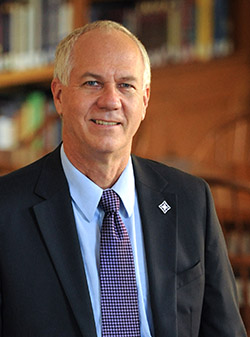 President James M. Harder became Bluffton’s ninth president in August 2006 after serving
the university as vice president for institutional planning for three years and before
that as special assistant to the president and professor of economics. Prior to his
positions at Bluffton, he was a professor of economics and business at Bethel College
in Kansas for 11 years.
President James M. Harder became Bluffton’s ninth president in August 2006 after serving
the university as vice president for institutional planning for three years and before
that as special assistant to the president and professor of economics. Prior to his
positions at Bluffton, he was a professor of economics and business at Bethel College
in Kansas for 11 years.
Jim earned his bachelor’s degrees in history and economics/business administration from Bethel College, followed by master’s and Ph.D. in economics from the University of Notre Dame. Through subsequent academic research and as a teaching economist, Harder has achieved recognition. His academic specialization is global economic and social change, especially as it relates to developing countries and to environmental issues.
He was active in the General Conference Mennonite Church administration and during the merging of Mennonite Church and General Conference Mennonite Church, was a member of the Transformation Team, Mennonite Church USA (1999-2001), working with nine individuals to design a new organizational strategy and structure for the merger.
Over the years, he has served with Mennonite Central Committee as a high school economics teacher in Kenya and worked with Mennonite Economic Development Associates (MEDA) and Canadian International Development Agency on a $3.5 million agricultural technology project in Tanzania
His passion for academics and scholarship coupled with strong faith fuel his desire to make an impact on the world of Christian higher education and to make Bluffton a larger part of that world.
Jim and his wife, Karen Klassen Harder, live in Bluffton. They have two grown children
Dr. Jane M. Wood
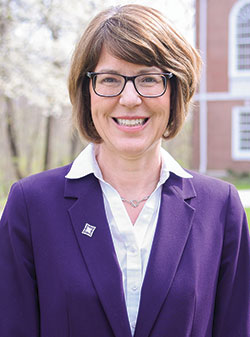
Dr. Jane Wood accepted the call to serve as Bluffton’s 10th president, beginning July 1, 2018.
She previously served as the vice president of academic affairs and dean at Mount Marty College, a Benedictine liberal arts institution in Yankton, S.D. Her previous professional positions were at Westminster College, in New Wilmington, Pa.; Park University and University of Missouri, both in Kansas City, Mo.; and at Baker University in Baldwin City, Kan. Her experience in higher education includes positions as a tenured faculty member, department chair, academic dean and vice president. Dr. Wood earned her Ph.D. and master’s degree in English literature from the University of Kansas and a bachelor’s degree in English literature from the University of Missouri.
Dr. Wood also has experience in implementing successful Title IX program improvements, including diversity hiring initiatives, and in fundraising. She has a breadth of experience with different college settings including serving for and interacting with students and faculty at public, private, and Catholic and Presbyterian institutions.

Living past presidents, in 2006
Clockwise from the right: Dr. Lee Snyder, Dr. Elmer Neufeld, Dr. Bob Kreider, Dr. Ben Sprunger, Dr. Jim Harder.